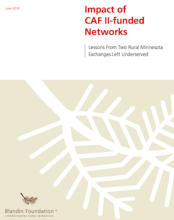Are CAF II Investments Helping Rural Minnesota? Blandin Report Looks at the Data - Community Broadband Bits Podcast 318

In the most recent report from the Blandin Foundation, Researcher Bill Coleman from Community Technology Advisors and his crew put boots to the ground to examine the results of Connect America Fund (CAF II) investments. Bill recently visited our office in Minneapolis to discuss the report with Christopher for episode 318 of the podcast.
You can download the report, Impact of CAF II-funded Networks: Lessons From Two Rural Minnesota Exchanges here.
Bill and Christopher discuss the challenges Bill and his team encountered when they initially decided to gather documentation on what services CAF II funded projects brought to rural Minnesota. In order to get past those challenges, the researchers devised a methodology that other communities can reproduce.
Once the team had answered the technical questions about infrastructure, they analyzed the results and applied them to Minnesota’s statewide goals for broadband access. They determined that, in addition to lack of transparency regarding CAF II network plans, the tendency to invest in slower speeds, including DSL, will not help Minnesota achieve its goals.
For people living in urban areas who have grown accustomed to broadband within reach, it’s hard to imagine the situation in rural Minnesota, where there are still homes that have no access to the Internet at all. The disparity in speeds and availability complicate the idea that rural folks should have access to high-quality connectivity at the same levels as people living in urban centers.
This show is 35 minutes long and can be played on this page or via Apple Podcasts or the tool of your choice using this feed.
Transcript below.
We want your feedback and suggestions for the show-please e-mail us or leave a comment below.
Listen to other episodes here or view all episodes in our index. See other podcasts from the Institute for Local Self-Reliance here.
Thanks to Arne Huseby for the music. The song is Warm Duck Shuffle and is licensed under a Creative Commons Attribution (3.0) license.


